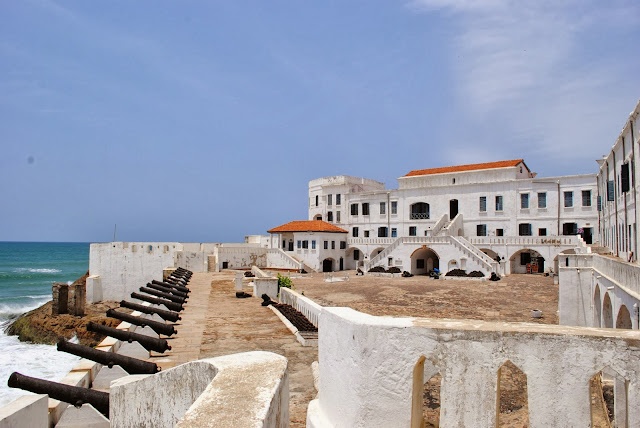On the edge of the Atlantic Ocean sits a “Castle” that was
built almost 400 years ago.
Have you ever visited the site of a famous battle—like
Gettysburg—or any historical place, really, be it an ancient cathedral or a
graveyard or even an art museum? The places that reek of memory, where the air
itself smells old and for some inexplicable reason people are compelled to step
softly and speak in whispers?
I have thought about this a lot. Why do we hush our voices?
Why do we tread lightly?
I think it is because when I stand in front of a piece of
pottery that is a thousand years old, or in the sanctuary of a church built
stone-by-stone, or on grass that was soaked with the blood of young men, I
taste my own smallness, my own insignificance, and I am—at least for a minute
or two—truly humbled.
Needless to say, the slave fort at Cape Coast was one of
those experiences.
The tour began in front of a plaque that was presented as an apology by
the chiefs across Ghana whose forefathers had perpetuated and engaged
in the slave trade. Our guide said, “Please do not come here to judge your
ancestors or the ancestors of others. Appreciate the history, learn what you
can, but do not judge. Only our Father in Heaven can judge—and we are all
sinners.”
We started by being escorted through the male dungeons,
surrounded by complete blackness, save for the small hole that was carved in
the top of one of the walls. The fort has been restored and outfitted with
electricity, but our guide neglected to use the lights most of the time. So we
would stand in the dark—hearing the waves crash against the rocks outside,
smelling the air, alternating between imagining and trying not to imagine what walls would say if they could talk.
Atop the male dungeon was a little room with a tiled roof.
“Oh,” said the guide, “that was the church for the slave
traders and governors.”
We were taken through the tunnels, through the female
dungeons, through the prisons set aside for those who rebelled,
through the bedrooms and watch towers for the soldiers and caretakers, atop the
ledges where cannons are rusting away and, if you peer down, kids are playing
soccer and fishermen are untangling their nets. We passed through the doors
marked, “POINT OF NO RETURN,” where they led shackled slaves out of the fort
and onto a platform where boats were docked to transport them to the Americas
or Caribbean.
One of the halls has been converted into a museum filled
with amazing pictures and artifacts: our guide dropped us off at the door and
said, “thank you for coming along with me, feel free to look around as long as
you like—we close at 4:30.”
(This is one aspect of Ghanaian life that differs
drastically from American. Every museum or historical site I have ever visited
is heavily secured, with roped off areas and huge DO NOT TOUCH signs. In Ghana,
you’re generally trusted to wander around and given freedom to explore.)
It would be easy, and even preferable, for me to condemn the
wrongdoers. But honestly, as Landon says, “But for the grace of God I
would be the same.” I hope that, if I had lived so many years ago, I would have
fought for the rights of humans despite the color of their skin, but I cannot know. I oppose slavery now, but so does the rest of the modern world. I
stepped inside the church that was literally built upon injustice and wondered
if in the silences between reading scriptures and singing hymns they could hear
the groaning of the peoples below. In retrospect our hearts are heavy and we wonder
how and why such evil endures. My question to myself is, “What cruelties will
my descendants witness—what historical sites will they tour—and ask why I did
nothing—why I sat idly by as brothers and sisters suffered?”
As I stood on the edge of the castle, watching the sea ebb
and flow, I was overwhelmed with feelings of smallness and inadequacy, and
likewise gripped with thankfulness and relief that our God is the God that sets
the captives free: that breaks chains and tears temple curtains in two and
turns mourning into dancing, ashes into crowns.
I’m grateful that whatever horrors are endured on earth God
can restore in a day, and that Jesus reigns supreme in the Kindgdom. That even
if I fail, which I will, he will be victorious.
 |
| Drawing of the castle, circa early 1700's |

 |
| Our guide explained that some of the walls are scarred from men and women scraping their shackles and chains, trying to dig their way out. |
 |
| The church and (below) the dungeons. |
 |
| That building on a hill in the distance is Fort William, another slave castle. This was taken from the "communication room"--you can see two other slave forts from other windows. |
 |
| View of Cape Coast to the left. |
 |
| cannon balls |
“Blessed is he whose help is the God of Jacob, whose hope is in the Lord his God, the Maker of heaven and earth, the sea, and everything in them—the Lord, who remains faithful forever. He upholds the cause of the oppressed and gives food to the hungry. The Lord sets prisoners free, the Lord gives sight to the blind, the Lord lifts up those who are bowed down, the Lord loves the righteous. The Lord watches over the alien and sustains the fatherless and the widow, but he frustrates the ways of the wicked. The Lord reigns forever, your God, O Zion, for all generations. Praise the Lord.”
Psalm 146:5-10







Beautifully written, Ellie. And great pictures throughout the blog, as well. :) Wish I could be there traveling around with you guys!
ReplyDelete